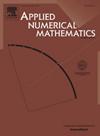Implicit integration factor method coupled with Padé approximation strategy for nonlocal Allen-Cahn equation
IF 2.4
2区 数学
Q1 MATHEMATICS, APPLIED
引用次数: 0
Abstract
The space nonlocal Allen-Cahn equation is a famous example of fractional reaction-diffusion equations. It is also an extension of the classical Allen-Cahn equation, which is widely used in physics to describe the phenomenon of two-phase fluid flows. Due to the nonlocality of the nonlocal operator, numerical solutions to these equations face considerable challenges. It is worth noting that whether we use low-order or high-order numerical differential formulas to approximate the operator, the corresponding matrix is always dense, which implies that the storage space and computational cost required for the former and the latter are the same. However, the higher-order formula can significantly improve the accuracy of the numerical scheme. Therefore, the primary goal of this paper is to construct a high-order numerical formula that approximates the nonlocal operator. To reduce the time step limitation in existing numerical algorithms, we employed a technique combining the compact integration factor method with the Padé approximation strategy to discretize the time derivative. A novel high-order numerical scheme, which satisfies both the maximum principle and energy stability for the space nonlocal Allen-Cahn equation, is proposed. Furthermore, we provide a detailed error analysis of the differential scheme, which shows that its convergence order is . Especially, it is worth mentioning that the fully implicit scheme with sixth-order accuracy in spatial has never been proven to maintain the maximum principle and energy stability before. Finally, some numerical experiments are carried out to demonstrate the efficiency of the proposed method.
非局部Allen-Cahn方程的隐式积分因子法与pad逼近策略
空间非定域Allen-Cahn方程是分数阶反应扩散方程的一个著名例子。它也是物理学中广泛用于描述两相流体流动现象的经典Allen-Cahn方程的扩展。由于非局部算子的非局域性,这些方程的数值解面临着相当大的挑战。值得注意的是,无论我们使用低阶还是高阶数值微分公式来近似算子,对应的矩阵总是密集的,这意味着前者和后者所需的存储空间和计算成本是相同的。然而,高阶公式可以显著提高数值格式的精度。因此,本文的主要目标是构造一个近似于非局部算子的高阶数值公式。为了减少现有数值算法的时间步长限制,我们采用紧凑积分因子法和pad近似策略相结合的方法对时间导数进行离散化。针对空间非局部Allen-Cahn方程,提出了一种既满足极大值原理又满足能量稳定性的高阶数值格式。此外,我们对微分格式进行了详细的误差分析,结果表明它的收敛阶为O(τ2+h6)。特别值得一提的是,在空间上具有六阶精度的全隐式格式从未被证明能保持最大原理和能量稳定性。最后,通过数值实验验证了该方法的有效性。
本文章由计算机程序翻译,如有差异,请以英文原文为准。
求助全文
约1分钟内获得全文
求助全文
来源期刊

Applied Numerical Mathematics
数学-应用数学
CiteScore
5.60
自引率
7.10%
发文量
225
审稿时长
7.2 months
期刊介绍:
The purpose of the journal is to provide a forum for the publication of high quality research and tutorial papers in computational mathematics. In addition to the traditional issues and problems in numerical analysis, the journal also publishes papers describing relevant applications in such fields as physics, fluid dynamics, engineering and other branches of applied science with a computational mathematics component. The journal strives to be flexible in the type of papers it publishes and their format. Equally desirable are:
(i) Full papers, which should be complete and relatively self-contained original contributions with an introduction that can be understood by the broad computational mathematics community. Both rigorous and heuristic styles are acceptable. Of particular interest are papers about new areas of research, in which other than strictly mathematical arguments may be important in establishing a basis for further developments.
(ii) Tutorial review papers, covering some of the important issues in Numerical Mathematics, Scientific Computing and their Applications. The journal will occasionally publish contributions which are larger than the usual format for regular papers.
(iii) Short notes, which present specific new results and techniques in a brief communication.
 求助内容:
求助内容: 应助结果提醒方式:
应助结果提醒方式:


